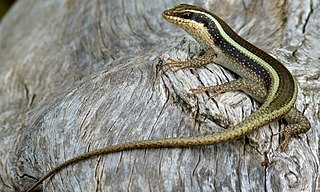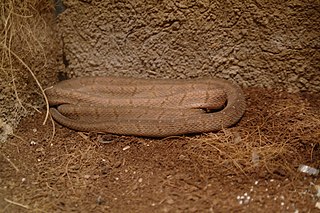
Lizards are a widespread group of squamate reptiles, with over 6,000 species, ranging across all continents except Antarctica, as well as most oceanic island chains. The group is paraphyletic as it excludes the snakes and Amphisbaenia; some lizards are more closely related to these two excluded groups than they are to other lizards. Lizards range in size from chameleons and geckos a few centimeters long to the 3 meter long Komodo dragon.

Cordylidae is a family of small to medium-sized lizards that occur in southern and eastern Africa. They are commonly known as girdled lizards, spinytail lizards, or girdle-tail lizards.

Skinks are lizards belonging to the family Scincidae, a family in the infraorder Scincomorpha. With more than 1,500 described species, the family Scincidae is one of the most diverse families of lizards.

The Florida sand skink is a species of lizard in the family Scincidae, the skinks. It is endemic to Florida in the United States.
Proscelotes is a genus of skinks. The genus is endemic to Africa.

Scincella lateralis is a small species of skink found throughout much of the eastern half of the United States, and into northern Mexico.

The Italian three-toed skink or the cylindrical skink is a species of lizard found from Italy, to northern Algeria, Libya, Morocco and Tunisia. It is common in some locations and is usually found in sunny areas with dense vegetation but can also be found in arid areas. They reach about 48 cm in length, out of which the tail constitutes more than half. Its body is long and snake-like, coloured usually between brown and olive and may have dark stripes on the back. Each of the highly reduced legs has three fingers. These skinks are active during daytime and prey mainly on insects. Females of the species give birth to live young. The population of this skink is slowly declining, but it has some tolerance to habitat modification.

The western three-toed skink is a species of lizard with tiny legs in the family Scincidae. It is found in the Iberian Peninsula, southern France and parts of northwestern Italy. Its natural habitats are temperate forests, temperate shrubland, Mediterranean-type shrubby vegetation, temperate grassland, sandy shores, arable land, pastureland, and rural gardens. It was first described 1829 by the French naturalist Georges Cuvier. The generic name comes from the Greek "chalcides" meaning 'copper' and the specific name is derived from the Latin "striatus" meaning 'streak'.
Günther's dwarf burrowing skink or Günther's burrowing skink was a species of skink in the family Scincidae. S. guentheri was endemic to Natal, South Africa.
Kasner's dwarf burrowing skink, also known commonly as Kasner's burrowing skink, is a species of lizard in the family Scincidae.

The African striped skink, commonly called the striped skink, is a species of lizard in the skink family (Scincidae). The species is widespread in East Africa and Southern Africa. It is not a close relation to the Australian striped skink, Ctenotus taeniolatus.

Trachylepis homalocephala, commonly known as the red-sided skink, is a small, slender species of skink in the subfamily Mabuyinae.

Marshall's pygmy chameleon, also called Marshall's leaf chameleon or Marshall's dwarf chameleon, is a species of chameleon found in the forests of Zimbabwe and Mozambique in Africa. It grows from 3.5 to 7.5 cm and feeds on insects. When standing still, it resembles a leaf on a branch.

Aspidelaps lubricus, commonly known as the Cape coral snake or the Cape coral cobra, is a species of venomous snake in the family Elapidae. The species is endemic to parts of southern Africa.

Dipsadoboa aulica, commonly known as the marbled tree snake, is a species of snake in the family Colubridae. The species is endemic to Africa, and is mildly venomous to humans.

Dasypeltis medici, known commonly as the East African egg-eater and the eastern forest egg-eater, is a species of nonvenomous snake in the family Colubridae. The species is endemic to Africa.

The black file snake, also known commonly as the dwarf file snake or the Nyassa file snake, is a species of snake in the subfamily Lamprophiinae of the family Lamprophiidae. The species is endemic to Africa.

Panaspis wahlbergi, also known commonly as the Angolan snake-eyed skink, the savannah lidless skink, and Wahlberg's snake-eyed skink, is a species of lizard in the family Scincidae. The species is indigenous to Sub-Saharan Africa.

Mochlus sundevallii, also known commonly as Peters' eyelid skink, Peters' writhing skink, and Sundevall's writhing skink, is a species of lizard in the family Scincidae. The species is endemic to Africa.















